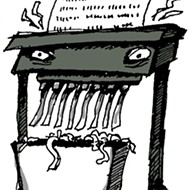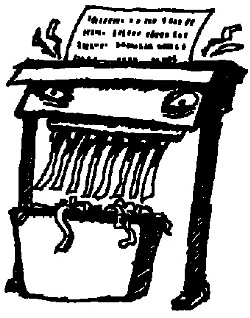Regulatory meltdown
[{
"name": "Newsletter Promo",
"id": "NewsletterPromo",
"class": "inlineCenter",
"insertPoint": "4",
"component": "15264767",
"requiredCountToDisplay": "0"
},{
"name": "Ad - Medium Rectangle CC01 - 300x250",
"id": "AdMediumRectangleCC01300x250",
"class": "inlineCenter",
"insertPoint": "8",
"component": "2963441",
"requiredCountToDisplay": "12"
},{
"name": "Ad - Medium Rectangle LC01 - 300x250",
"id": "AdMediumRectangleCC01300x250",
"class": "inlineCenter",
"insertPoint": "18",
"component": "2963441",
"requiredCountToDisplay": "22"
},{
"name": "Ad - Medium Rectangle LC09 - 300x250",
"id": "AdMediumRectangleLC09300x250",
"class": "inlineCenter",
"insertPoint": "28",
"component": "3252660",
"requiredCountToDisplay": "32"
}]
Three weeks ago, my great-grandmother kicked me out of her house with only six months’ notice and $200 to help me get on my feet. I wouldn’t care—I’m so accustomed to sleeping at my desk during work hours, I don’t think I’d mind doing it at night—except that the old biddy is also withholding her services as unpaid chauffeur.
Which is how I found myself at the DMV putting my NASCAR skills to the test with a government agent holding a clipboard and documenting my every move from the passenger seat. It wasn’t so bad, actually.
“That was a stop sign! Oh, you didn’t see it? Well, how about we just pretend that didn’t happen? Now, I see you’re going 73 in a 35 zone, and if you don’t slow down soon I’m going to have to report you for it. OK … you almost hit a pedestrian. He’s a quick-moving fellow, huh? Well, ‘almost’ doesn’t count, right? Here’s your license, Citizen Shredder.”
All right, so maybe that’s not how it actually went down. That’s certainly how it would have gone down if the Nuclear Regulatory Commission were responsible for overseeing licensing to operate a motor vehicle. Fortunately, they’re just responsible for keeping an eye on nuclear plants, and I’m sure a car can do a lot more damage than a nuclear reactor. Worst-case scenario, our dry, brown hills turn a vibrant, radioactive green and our wildlife sprouts a spare eyeball or tentacle. Sounds like tourism gold, if you ask me.
As for the reason a concerned citizen might justifiably jump down the NRC’s throat for its lackadaisical oversight of nuclear reactors in general, and PG&E’s Diablo Canyon specifically: In the fall of 2011, against the recommendation of one of the few inspectors who seemed to be asking the right questions, the NRC agreed to allow PG&E to eliminate two out of three of its seismic safety requirements because the company knew it couldn’t meet them. That’s like the person administering the driving test for the DMV eliminating the requirement that I signal before turning because I don’t know how to flick a blinker. Of course, lowering the standards at the DMV might result in a fender bender, whereas worst-case scenarios for Diablo involve everyone dying from radiation poisoning. Hopefully we’ll all grow flippers first.
The timing of this decision—a mere seven months after the Fukushima disaster, seven months after the world realized what could happen if we don’t take these things seriously—doesn’t do much to mitigate the impression that the NRC is once again bending over for PG&E, at everyone’s expense. It’s actually not all that surprising that PG&E is playing dirty here. They are, after all, going to milk the taxpayers for every penny we’re willing to pay, for as long as we’re willing to pay, whether they’re using a nuclear plant that meets the most stringent safety requirements or not. The real villain is the so-called regulatory commission, which has become indistinguishable from PG&E’s PR company.
“PG&E chose not to do all three [tests] because it’s a waste of money,” said one PG&E spokesperson—er, I mean NRC branch chief. It’s so easy to get the two mixed up sometimes. In fact, if you removed the attribution from “Calculatory garbage” (page 10), I’ll bet you couldn’t differentiate the PG&E spokespeople from the people being paid to oversee and regulate PG&E. Given what’s at stake, that’s a bit of a problem. Referring to tests that assess safety standards at a nuclear plant as “a waste of money” is bad enough if you’re a PG&E employee. Coming from the “regulator,” it’s downright ludicrous. Throw in the fact that a PG&E supervisor wanted to use an NRC seismologist who’s “on our side”—and in case you’re dense, the “our” they’re referring to is not the ratepayer or the average citizen, but PG&E—in an argument with the one NRC inspector who actually seemed to take his job seriously, and the situation escalates from ludicrous to outrageous.
Then we get PG&E spokesperson—crap, again, I’m sorry—NRC spokesperson Lara Uselding assuring us that Diablo is safe and that her colleague has no concerns about the plant’s safety. Meanwhile, that same colleague is insisting he has concerns about the plant’s safety. All because PG&E managed to exploit the fact that the NRC is paying lip service to public safety in the wake of Fukushima by creating more stringent standards for nuclear plants—standards the NRC has already acknowledged Diablo won’t and can’t meet. Conveniently for PG&E, they don’t have to meet these terribly necessary more stringent safety requirements until 2018 anyway. And even if they can’t, won’t, and don’t, the smart money’s on the utility company sweet-talking its way out of the requirement anyway.
Let’s keep in mind that this is a regulatory commission that has never turned down an application to relicense a plant. No one knows what the NRC putting its foot down would look like, or whether the commission is even capable of putting its foot down, or whether it has feet. Maybe it already has flippers. If someone asked for a portrait of the commission, I’d probably draw you a green light with its thumbs up its ass—or up PG&E’s ass, depending on how the utility company likes it.
Oh, and a word to NRC spokespersons: Don’t forget to consult with PG&E and get their permission before responding to this column.
Shredder doesn’t want to die in a nuclear meltdown, but does want fins. Send just enough radiation to shredder@newtimesslo.com.
How do you feel about the Santa Maria Speedway reopening?
Latest in Shredder
Readers also liked…
-

It ain't pretty
May 4, 2023 -

Carrot kingpins
Aug 17, 2023







